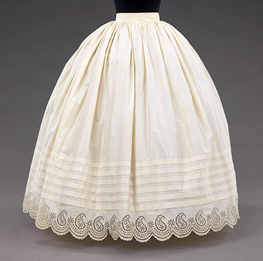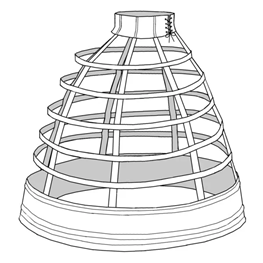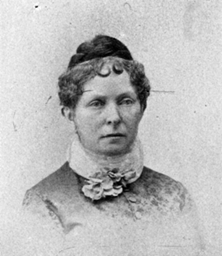The 1850s; a time for new, more ostentatious fashion, the underground railroad, and even a war over the destiny of the local train tracks. The world certainly had its fair share of events happening, but Erie’s history at this time is truly unique, as is the involvement that women had in these events.
Fashion: A Whole New Width
The appearance of the trendy woman was one that changed considerably going into the 1850s. The days of the constricting tight-laced corsets of the past were coming to an end, as shorter flared corsets came into style. These flared corsets, of course, matched with the way that dresses themselves became more and more voluminous over time. Some had matching flounces (the tiered frills going down the dress) to emphasize just how large the dress was! Our dress, as you can see, shows off this effect.
You may be asking “how did the women of the era get their dresses so wide?” Well, in the early 1850s, this was done with multiple petticoats underneath the dress. The more petticoats you added the wider the dress became, although it became more burdensome to wear as well. Although the usual number of them was 2, it was often seen as more fashionable to wear more, with women sometimes wearing as many as 7 petticoats underneath one dress! Luckily, this did not last for too long, as the “cage crinoline” came into existence. This device was a series of metal hoops a woman could wear under her dress to give it the same flared appearance, without the cumbersome petticoats.


Along with this look, women usually had high necklines and white collars with their dresses. Due to the increased popularity of skirts however, a woman could switch to a much lower neckline for the evening while keeping her skirt on. How convenient!
Erie History and The Women That Contributed
Metta Victoria Fuller was born in Erie in 1831. She was an author who attended school at the Erie Academy for her early education, before moving to Ohio at the age of 9. Despite her youth she began to write, and by age 13 she published her first story. At age 15, Metta began her career as a romantic novelist and became a favorite of the readers of the time. In 1948 she moved with her sister to New York city and began to work on her literary career in earnest. By 1853, she wrote her first bestseller, The Senator's Son. Her work at this time tended to focus on social issues, with this book being a temperance novel. While most of her more well-known work began to be published in the 1860s, the 1850s showed a promising start to an important Erie born author.

The Underground Railroad was also a place where women were quite prominent during the 1850s, as Erie was a perfect location to help runaway slaves escape. It was possible for a slave to escape by ship to Canada, cross the ice in the winter, or take a path along the lake to Buffalo. All manner of people, men, women, and children, helped watch over the railroad at different stopping points. Many of these names have been lost to time, but luckily various Erie County records managed to save a couple.
Mrs. Kellogg was one of these names. Daniel Dobbins was a local shipmaster that came to Mrs. Kellog for help, as he had an escaped slave, William Mason, in his employ. As slave hunters arrived and were attempting to get legal papers in order, Mrs. Kellogg hid the frightened William so well that “The devil himself could not have found him,” as Dobbins later stated. Afterward, Daniel was able to bring William aboard a ship to Canada, allowing him to be truly free.
Mary Rogers Crawford was another woman who was called upon to help with the underground railroad. Crawford lived in North East near the lake, along with her husband and 11 children. Mary’s husband James actively aided runaway slaves in finding their way to freedom, which Mary wholeheartedly supported. One evening a slave names Ned arrived at their house. Mary gave him food and a bed to sleep in. Before long a “station agent” came to warn them that a search party was only a mile away. Ned left with the agent as Mary, knowing the search of their home would be thorough, moved one of her children into the bed where Ned had slept. As the sheriff searched the house the deception was successful, and the sheriff left without any evidence. Unfortunately, despite Mary’s brave work, Ned was still captured as he boarded a ship to sail across the lake and was returned to his “owners.” Mary commented some 50 years later that apparently the money paid to the informant for telling the sheriff of Ned’s location brought only bad fortune, as they lost it all on attempting to buy land in the south.
The Erie Gauge War
Hearing a title like “Gauge War” might surprise you if you are native to Erie. A war? I certainly never heard of such an event, and it was not taught in the local schools. In 1853, Erie was involved with a controversial event that tore apart the community and caused many of the surrounding cities hate Erie for a long while.
During the early 1850s, Erie and the surrounding areas within New York and Ohio were working on the completion of connecting railroads. At the time, railroads were not standardized, meaning that the measurement between the tracks, or the gauge, could be different between areas. The problem is that the railroad heading West of Erie had a gauge of 4’10”, but the railroad heading East had a gauge of 6’0”. This led to trains being forced to stop in Erie to allow passengers to switch trains to continue their journey. Erie wanted to become a local hub, however; due to the inconvenience of this gauge problem the railway companies agreed to make the track narrower going into New York, making the stop in Erie no longer a necessity.

Predictably, the people of Erie disliked this change due to the impact on local businesses. To fight the rail companies, 4 months before the agreement of a 6-foot gauge was made, the city council of Erie enacted an ordinance that made it illegal for railroads to cross the city streets. After they discovered the tracks were being laid anyways, council reconvened and allowed the mayor to call in the city’s police to destroy any tracks laid across the city streets. On December 7th, 1853, the mayor led a group of 150 police constables to the bridges over State and French Streets, tearing them down to prevent the gauges from being changed.
This violent act was an event of great controversy within Erie and caused a great deal of tension between those who lived here. Many people supported the stopping of people within Erie, but not the violence behind the destruction. Those dedicated to destroying the tracks were known as “Rippers,” and the women who sympathized with them were known as the “Ripper Women.” The women took part in the aggression by boycotting any businesses known to sympathize with the ideas of the rail companies. This tension caused friends and families to split, as well as dividing the First Presbyterian Church, causing half of them to leave and form Park Presbyterian. This issue was eventually resolved when, in 1854, the Pennsylvania government ensured that the trains going by Erie would still stop, even with a standardized track gauge. Even with this resolved though, Erie citizens still felt strongly about their own side, and the community collectively tried to avoid discussion of the topic.
